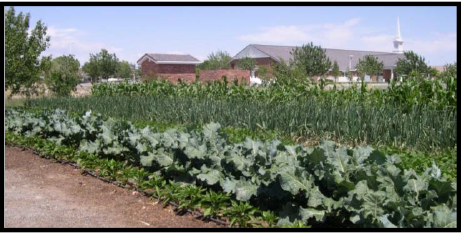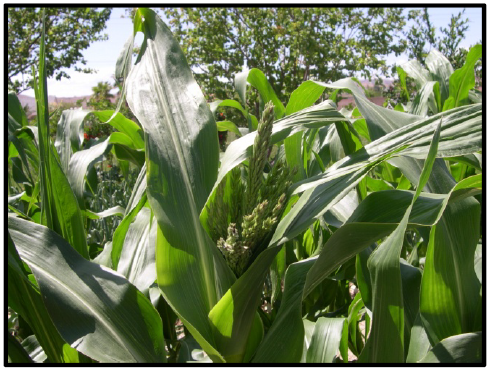Introduction
Vegetable Gardening in the Moapa and Virgin Valleys (University of Nevada Cooperative Extension Special Publication 09-01) authored by Sylvan Wittwer is requested on a regular basis and is considered the essential vegetable-growing manual for the area. Excerpts from that publication and input from other longtime local growers have been used as the basis for this publication. The purpose of this publication is to emphasize the selected vegetable varieties or cultivars (seeds/plants) that may perform better than others in the Moapa and Virgin Valleys.
The climate here is comparable to that of Egypt along the Nile River Valley. In both areas there are three major growing seasons: fall, winter and spring. Rainfall averages about 4 inches per year. Precipitation is both unpredictable and localized. Average daytime temperatures during July and August usually peak above 100 F, with readings often 110 F to 120 F during early afternoon, and 65 F to 95 F at nighttime. The differences between day and night temperatures at ground level may be as much as 50 F. The soil is alkaline with a high salt content.
Use the climatic conditions to your best advantage. Take advantage of the climatic resources of the Moapa and Virgin Valleys by the use of site selection. Extend the spring season by using transplants, row and plant covers, and wise selection of varieties. Take advantage of the sun with row orientation and provide protection by using shade covers. Take advantage of fall and winter production for cool-season crops to avoid weeds, reduce water requirements, improve produce quality and enjoy working in cooler temperatures.
Seed companies may not stock varieties of some vegetables well adapted for the valleys. Gardeners are encouraged to trade with their neighbors who have successfully grown an outstanding variety. The local Cooperative Extension office can provide information on how to save and collect seeds from older open-pollinated cultivars. While only selected vegetables that have proven particularly successful are included in this publication, readers are encouraged to experiment with other cultivated vegetable varieties that may be of interest.
Beans
Varieties in seed catalogs are not always reliable; for sale purposes, companies promote all varieties listed in their catalogs even though they will not do well in all climates. The varieties below are known to do well here.
- Calypso, Jacob’s Gold Cattle Bean, Jacob’s Cattle Bean, Black Valentine and Mayflower – All are nonhybrid and will pollinate themselves before their flowers open. They aren’t very good as green beans as they have a tough shell, but are easy to shell when they dry.
- Calypso, Jacob’s Gold Cattle Bean, Jacob’s Cattle Bean, Black Valentine and Mayflower – All are nonhybrid and will pollinate themselves before their flowers open. They aren’t very good as green beans as they have a tough shell, but are easy to shell when they dry.
- Florence, Top Crop, Blue Lake and the flat-podded, beany-tasting Romano – All are good choices for our area.
Broccoli
There are many to choose from – Green Comet, Green Goliath, Early Dividend, Packman, Southern Comet Hybrid and Premium Crop. All have vigorous, tender side shoots and are adapted for fall, winter and early spring plantings in these valleys. Wittwer preferred Premium Crop.
- DeCicco – This heirloom Italian variety is known for tender stalks and mild flavor. It is a reliable, multi-cut variety that produces a compact, 3 to 4 inch bluish-green central head followed by a prolific set of side spears.
- Premium Crop – This variety has large (l pound or more), compact green heads, vigorous growth and tender side shoots. Seeds of these varieties are all available from several seed companies.

Cabbage, onions and corn growing in an early spring garden.
Corn, Sweet
A major consideration for our area is finding varieties that will germinate in the cold soils of late winter or early spring. Sweet corn varieties also differ greatly in their tolerance of heat and hot, searing winds, in vigor of early growth, in sweetness, in earliness of maturity, in plant height and in implanting by the strength of anchor roots to resist wind damage. The sweetest varieties of sweet corn are usually late in maturity (80+ days). Select yours and enjoy!
- Delectable – Will germinate in the cold soils of late winter or early spring. 80 days.
- Rainbow Sweet Inca Corn – Beautiful and multicolored sweet corn is wonderful cooked fresh, when the colors are still very pale; has a delicious real corn flavor. Mature ears are great for grinding into flavorful flour and are perfect for fall decorations. The kids will love this one.
- Seneca Arrowhead – This is one of the earliest corns to produce. 62 days.
- Sweet Rhythm – The best variety for our area it will germinate in the cold soils of late winter or early spring. Sweet Rhythm produces a preponderance of double ears accompanied by vigorous early growth, is an abundant pollen producer somewhat resistant to “blasting,” and produces ears full of kernels. 74 days. (pictured below)
- Sweet Symphony – This variety will germinate in the cold soils of late winter or early spring. 76 days.
- Illini Extra Sweet, Sweetie 82 or Candy Store (an 81-day bicolor) – These three are the sweetest varieties of sweet corn.

Corn growing in a fall garden.
Globe Artichokes
Globe Artichokes are a perennial plant that can be grown for both edible flower buds and showy garden flowers. The open flowers are purple in color and will grow up to a diameter of 7 inches if not harvested.
- Green Globe – The Green Globe Artichoke is the king of the artichokes – it’s the one you’re most likely to find in your local supermarket or at your favorite restaurant.
- Imperial – Imperial Star will produce well-developed artichokes the first year from seed. Plants become 1 ½-3 feet tall and have an open growth habit. Each typically produces one or two primary buds, with a diameter of 3 or 4 inches, and five to seven smaller secondary buds.
- Violetta – Lovely, pointed, purple heirloom artichokes. Purple varieties have been popular in Italy for hundreds of years and are more tender than green types.
Melons
Melons are very nutritious being especially high in vitamin C and the carotenoids with a high concentration of lycopenes. These are coupled with many healthful phytochemicals.
Muskmelons
Muskmelons’ skin and flesh can range from green to white, yellow or orange.
- Acoma – Fruit are round or oval, with smooth yellow skin and ribs. Flesh is white to salmon-colored with a mild, sweet flavor.
- Isleta Pueblo – This orange- and green-fleshed, ribbed melon is from Isleta Pueblo near Albuquerque, NM and is heat adapted.
- Mayo Minol – This sweet, yellow-fleshed melon is heat and drought resistant.
- Santo Domingo Casaba – Originally collected in Santo Domingo Pueblo, this is a casaba-type melon. The skin is slightly wrinkled; the flesh is white to light green and sweet and tasty.
Watermelons
Watermelon is a food that is almost synonymous with summertime. There is nothing finer than finishing a leisurely meal with a big slice of the sweet, juicy fruit. Watermelons are available in many different sizes, shapes, colors and flavors because they have been grown for so many centuries.
- Black Diamond – This very popular round variety is premium quality and size (averages 35 to 50 pounds, but can get much larger). Flavorful red flesh, bruiseresistant rinds. 90 days.
- Crimson Sweet, Charleston Grey, Tom Watson or Klondike – These are superb local grown varieties.
- Moon and Stars – This large-fruited, huge seeded melon has dark-green rind speckled with tiny yellow dots (the stars) surrounding one or more larger yellow spots (the moon). It has a sweet, old-fashioned sit-on-the-stoop-and-spit-the-seedsonto- the-lawn flavor.
Peas
There are two major types of peas: the old-time garden or English peas that are shelled to remove them from the tough and inedible pod. Snap or sugar podded peas produce tender, edible pods that are usually harvested when the pea seeds are small or undeveloped. The snap pods and peas will stay tender and sweet when fully developed. There are also both early- and late-maturing varieties. Wittwer preferred the early bush type of both the garden (shelled) and the sugar snap peas.
- Cumpas Green – This smooth green pea from central Sonora is used in soups.
- Greater Progress, Laxton Progress or Progress No. 9 – These favorites for early shelled peas. All are dwarf of about equal maturity and perform well from November plantings.
- Maestro Shelling – A favorite in the Southwest because of its double pods and heat resistance. This variety has large, sweet peas in 4-inch pods on 27-inch vines. It is resistant to virus, mildew and mosaic.
- Sugar Ann Snap – This is the earliest snap pea. Its short vines need no support. Both pods and peas develop well and are exceptionally sweet. Eat fresh in the garden!
Sweet Peppers
Sweet peppers come as both open pollinated and hybrids. Produce outlets in the U.S. offer sweet peppers of the bell type as green, yellow, orange and red year-round. Heart-shaped pimentos come both as hot and sweet and of different sizes.
- Big Bertha – This variety is green, big and beautiful.
- California Wonder – An excellent green bell pepper of nice size and very good yield, it is a popular old-time variety. 70 days.
- Crispy Bell – This pepper is good for early spring planting, and matures early. The plants are stocky and sturdy but upright and provide excellent foliage cover for the developing fruit.
- Gypsy – Tapered fruits grow 4 ½ inches long and mature from yellow to orange to red.
- Hungarian Banana Sweet – Peppers turn scarlet when fully ripe, but stay sweet and mild. This pepper can be eaten yellow or red.
- Pimento – This variety is very sweet at maturity, and dark green to deep bright red.
- Red Beauty – This pepper is good for early spring planting and matures early. It is widely adapted and easy to grow. Blossom pruning will improve fruit size.
- Yolo – This common variety is grown as transplants and provided by local nurseries.
Squash
Both winter and summer squash are warm season vegetables that can be planted early in the spring and in mid to latelate summer, as well. Winter squash is picked when mature and can be stored over the winter, while summer squash is picked in its immature state and is consumed soon after harvest. Wittwer simply did not grow certain vegetables (some because he did not wish to eat them, therefore, he had no reason to grow them). However, his son suggested that perhaps he didn’t grow squash because he hated the bugs that trouble them here.
Summer Squash
Summer squash are grown for immature fruits that can be harvested all season long.
- Bennings Green Tint Scallop – This colorful light-green scalloped-shaped fruit is tender and of good quality. It has excellent yields, is easy to grow and handles the heat very well.
- Costata Romanesque – This famous Italian/Roman ribbed zucchini has distinctive, long fruit that is fluted and ribbed with medium green-striped skin. It is rich and very flavorful. The cut slices are scalloped!
- Early Prolific Straightneck – This uniform lemon-yellow, club-shaped fruit is tasty and has firm flesh of excellent quality. 50 days.
- Odessa Squash – The vining plants produce delicious white zucchini-type fruit that will fruit long into November.
- Yellow Crookneck – This yellow variety has a buttery flavor and firm texture. Big plants are late to begin bearing, but then yield consistently over a long picking period.
Winter Squash
Harvest in autumn when the seeds within have matured fully and the skins are too tough to be easily punctured with a thumbnail.
- Delicata – This squash has a high sugar content, a delicate sweet flavor, and a skin color that is rust-white with green stripes.
- Golden Delicious – Fruit are teardrop shaped and weigh 7to 9 pounds with brilliant red-orange rind. Flesh is very smooth, tasty and orange. These squash are delicious!
- Jack O’Lantern Pumpkin – This pumpkin is excellent for Halloween carving and cooking. Fruit is medium sized, and round to elongated in shape. 110 days.
- Moapa Squash – Originally an old heirloom Cushaw winter squash, it has cross pollinated with other varieties for years and is now the “Moapa Squash.” The flesh has a beautiful light-salmon color with a delightfully mild flavor. This squash is very hardy for our area and is rarely affected by squash bugs.
- Spaghetti Squash – this unique squash has yellow spaghetti-like strands of flesh.
- Table Gold Acorn – Beautiful gold acorn-shaped fruit are perfect for fall displays, they are nutty flavored with yellow flesh. The bush is very compact.
Tomatoes
There are many tomato plants that will do well in the Moapa and Virgin Valleys. However, there are only a few that will last, and produce through the summer. It isn’t that the plant won’t live, but many of the varieties are “determinant.” They have a very determined life cycle, and stop producing at some point in the summer. “Indeterminant” varieties will grow to maturity and produce fruit until the frost kills them. There are hundreds of varieties to choose from so select your favorites and grow them. Some like the fruits large, some small; some want Roma, cherry, pear or grape types. Some want them red, green, pink, orange or yellow. Some want them acid, others sweet. Wittwer preferred those that were semi-determinate, red and large (two to three tomatoes per pound).
- Celebrity – Red, large, globe-shaped (round), semi-Determinate, tomato has a small green core with a minimum of cracking and is resistant to blossom end rot.
- Champion – Red, large, globe-shaped (round), indeterminate, tomato has a small green core with a minimum of cracking and is resistant to blossom end rot.
- Cherokee Purple – Legend has it that this tomato was grown by the Cherokee tribe. It has a distinctive purple-pink-brown color, and a sweet, rich flavor, growing on relatively indeterminate, short vines.
- Fourth of July – This hybrid is indeterminate with small (4 ounces) red/pink fruit.
- Hawaiian Tropic – This very heat-tolerant, hybrid, indeterminate tomato has delicious 8 to 10 ounce meaty and succulent fruit.
- Heartland – This dwarf indeterminate variety grows to about 3 feet and has big leaves. The tomatoes are tasty and weigh about 6 to 8 ounces each.
- Heat Wave II – This determinate, hybrid has red, medium (7 ounces) fruit. 68 days.
- Juliet – This small (1 to 2 ounce), indeterminate hybrid has Roma-shaped fruit that is very good tasting. 60 days.
- President – Red, large, globe-shaped (round) tomato has a small green core with a minimum of cracking and is resistant to blossom end rot.
- San Marzano – The large, indeterminate vines produce elongated fruit. They are crack resistant and hold well on the vine or in storage.
- Solar Fire – Known for bearing heavy loads of medium-sized red tomatoes in summer’s heat. This hybrid is indeterminate and can be planted in spring or at midseason to extend the harvest into fall.
- Super Sioux –This good crack-resistant, heirloom variety is Indeterminant and sets well in high temperatures and dry conditions. It is suitable for our hot summer region and produces good yields of red globe-shaped tomatoes. 70 days.
- Top Gun – Bred primarily for the Southeast region of the U.S., this determinate plant produces high yields of large 8 ounce deep-red tomatoes. Determinate.
- Yellow Pear – Long, indeterminate vines produce a seemingly endless supply of mild-flavored, pear-shaped, cherry tomatoes all summer.
Summary
We have concentrated on varieties of certain vegetable types; listed below are some considerations before choosing which vegetables to plant.
- Beans are the elixir of kings and queens. Green bean pods are straight, green and tender. They can be eaten either raw or cooked using your favorite recipe.
- Broccoli is the super vegetable for production in the Moapa and Virgin Valleys. In these valleys it can be harvested with superior quality from October to May.
- Sweet corn is not an easy crop to grow in the Moapa and Virgin Valleys. There is a very small window of time when temperatures are optimal for pollination and ear development.
- Melons are refreshing and a delight to eat, especially during the hot summer and early fall months in our Valleys.
- Peas are one of the oldest cultivated vegetables. Sweet and tender, fresh peas are more like a dessert than a vegetable.
- Peppers are among our greatest food treasures and display an amazing diversity of colors, sizes, shapes, flavors, spiciness, plant architecture.
- Potatoes can be successfully grown in the Moapa and Virgin Valleys if planted in late winter or very early spring.
- Tomato production in our Valley is confined to a very narrow window of time determined by night temperatures.
References
Climate information from Desert Research Institute for Community Environmental Monitoring Program station at Overton, Nevada available at: CEMP
Sunset Western Garden Book. Seventh Edition; Sunset Publishing Corporation, Menlo Park, CA.
O’Callaghan, Angela. (2002). Home Vegetable Production in Southern Nevada. University of Nevada Cooperative Extension Fact Sheet 02-61.
Wittwer, Sylvan, Alice Crites and Pamela Proctor. (2004) Vegetable Gardening in Moapa and Virgin Valleys. University of Nevada Cooperative Extension Special Publication 09-01.

Maurine and Sylvan Wittwer Sylvan Harold Wittwer, 95, passed away on Jan. 20, 2012.
Bishop, C. and Stoesser, D.
2013,
Fruit, Flower and Seed Vegetable Varieties for the Moapa and Virgin Valleys,
Extension | University of Nevada, Reno, FS-13-05


